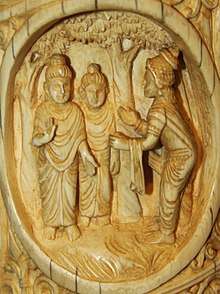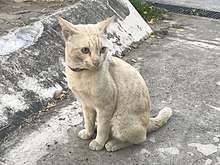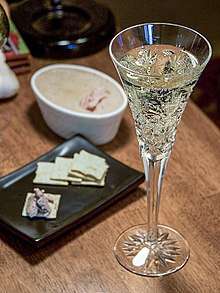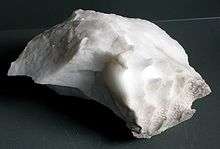Shades of white
Shades of white are colors that differ only slightly from pure white. Variations of white include what are commonly termed off-white colors, which may be considered part of a neutral color scheme.
| White | |
|---|---|
| Hex triplet | #FFFFFF |
| sRGBB (r, g, b) | (255, 255, 255) |
| CMYKH (c, m, y, k) | (0, 0, 0, 0) |
| HSV (h, s, v) | (0°, 0%, 100%) |
| Source | By definition |
| B: Normalized to [0–255] (byte) H: Normalized to [0–100] (hundred) | |
In color theory, a shade is a pure color mixed with black (or having a lower lightness). Strictly speaking, a “shade of white” would be a neutral beige. This article is also about off-white colors that vary from pure white in hue, and in chroma (also called saturation, or intensity).
Colors often considered "shades of white" include cream, eggshell, ivory, Navajo white, and vanilla. Even the lighting of a room, however, can cause a pure white to be perceived as off-white.[1]
Off-white colors were pervasively paired with beiges in the 1930s,[2] and especially popular again from roughly 1955 to 1975.[3]
Whiteness measures the degree to which a surface is white in colorimetry.
Web colors
Below is a chart showing the computer web color shades of white. An achromatic white is a white color in which the red, green, and blue codes are exactly equal. The web colors white and white smoke are achromatic colors. A chromatic shade of white is a white color in which the red, green, and blue codes are not exactly equal, but are close to each other, which is what makes it a shade of white.
| HTML color name | Sample | Hex triplet | |
|---|---|---|---|
| (rendered by name) | (rendered by hex triplet) | ||
| White | #FFFFFF | ||
| Whitesmoke | #F5F5F5 | ||
| Snow | #FFFAFA | ||
| Honeydew | #F0FFF0 | ||
| Mintcream | #F5FFFA | ||
| Azure | #F0FFFF | ||
| Aliceblue | #F0F8FF | ||
| Ghostwhite | #F8F8FF | ||
| Seashell | #FFF5EE | ||
| Beige | #F5F5DC | ||
| Oldlace | #FDF5E6 | ||
| Floralwhite | #FFFAF0 | ||
| Ivory | #FFFFF0 | ||
| Antiquewhite | #FAEBD7 | ||
| Linen | #FAF0E6 | ||
| Lavenderblush | #FFF0F5 | ||
White
White (#FFFFFF)
#FFFFFF
| White | |
|---|---|
| Hex triplet | #FFFFFF |
| sRGBB (r, g, b) | (255, 255, 255) |
| CMYKH (c, m, y, k) | (0, 0, 0, 0) |
| HSV (h, s, v) | (0°, 0%, 100%) |
| Source | By definition |
| ISCC–NBS descriptor | White |
| B: Normalized to [0–255] (byte) H: Normalized to [0–100] (hundred) | |
White is a color, the perception of which is evoked by light that stimulates all three types of color sensitive cone cells in the human eye in equal amounts and with high brightness compared to the surroundings. A white visual stimulation will be void of hue and grayness. White is the lightest possible color.
Ghost white
Ghost white (#F8F8FF)
#F8F8FF
| Ghost white | |
|---|---|
| Hex triplet | #F8F8FF |
| sRGBB (r, g, b) | (248, 248, 255) |
| CMYKH (c, m, y, k) | (3, 3, 0, 0) |
| HSV (h, s, v) | (240°, 3%, 100%) |
| Source | X11[4] |
| ISCC–NBS descriptor | White |
| B: Normalized to [0–255] (byte) H: Normalized to [0–100] (hundred) | |
The web color ghost white is a tint of white associated with what the 'creator' of the color imagined the hue of a ghost could be.
There is no evidence that this color name was in use before the X11 color names were formulated in 1987.
White smoke
White smoke (#F5F5F5)
#F5F5F5
| White smoke | |
|---|---|
| Hex triplet | #F5F5F5 |
| sRGBB (r, g, b) | (245, 245, 245) |
| CMYKH (c, m, y, k) | (0, 0, 0, 9.95) |
| HSV (h, s, v) | (0°, 0%, 96.1%) |
| Source | X11 |
| ISCC–NBS descriptor | White |
| B: Normalized to [0–255] (byte) H: Normalized to [0–100] (hundred) | |
The web color white smoke is displayed on the left.
There is no evidence that this color name was in use before the X11 color names were formulated in 1987.
Baby powder
Baby powder (#FEFEFA)
#FEFEFA
| Baby powder | |
|---|---|
| Hex triplet | #FEFEFA |
| sRGBB (r, g, b) | (254, 254, 250) |
| CMYKH (c, m, y, k) | (0, 0, 2, 0) |
| HSV (h, s, v) | (60°, 2%, 100%) |
| Source | Crayola |
| ISCC–NBS descriptor | White |
| B: Normalized to [0–255] (byte) H: Normalized to [0–100] (hundred) | |
The Crayola crayon color baby powder was introduced in 1994 as part of its specialty Magic Scent crayon collection.
Snow
Snow (#FFFAFA)
#FFFAFA
| Snow | |
|---|---|
| Hex triplet | #FFFAFA |
| sRGBB (r, g, b) | (255, 250, 250) |
| CMYKH (c, m, y, k) | (0, 2, 2, 0) |
| HSV (h, s, v) | (0°, 2%, 100%) |
| Source | X11[4] |
| ISCC–NBS descriptor | White |
| B: Normalized to [0–255] (byte) H: Normalized to [0–100] (hundred) | |
The web color snow is displayed at left.
The first recorded use of snow as a color name in English was in 1000.[5]
The color snow was included as one of the X11 colors when they were formulated in 1987.
Ivory
Ivory (#FFFFF0)
#FFFFF0
| Ivory | |
|---|---|
| Hex triplet | #FFFFF0 |
| sRGBB (r, g, b) | (255, 255, 240) |
| CMYKH (c, m, y, k) | (0, 0, 6, 0) |
| HSV (h, s, v) | (60°, 6%, 100%) |
| Source | X11 |
| ISCC–NBS descriptor | Pale yellow green |
| B: Normalized to [0–255] (byte) H: Normalized to [0–100] (hundred) | |
Ivory is an off-white color that resembles ivory, the material out of which the teeth and tusks of animals (such as the elephant and the walrus) are made. It has a very slight tint of yellow.
The first recorded use of ivory as a color name in English was in 1385.[6]

The color ivory was included as one of the X11 colors when they were formulated in 1987.
Floral white
Floral white (#FFFAF0)
#FFFAF0
| Floral white | |
|---|---|
| Hex triplet | #FFFAF0 |
| sRGBB (r, g, b) | (255, 250, 240) |
| CMYKH (c, m, y, k) | (0, 2, 2, 0) |
| HSV (h, s, v) | (40°, 6%, 100%) |
| Source | X11[4] |
| ISCC–NBS descriptor | Pale yellow green |
| B: Normalized to [0–255] (byte) H: Normalized to [0–100] (hundred) | |
The web color floral white is displayed at left.
There is no evidence that this color name was in use before the X11 color names were formulated in 1987.
Seashell
Seashell (#FFF5EE)
#FFF5EE
| Seashell | |
|---|---|
| Hex triplet | #FFF5EE |
| sRGBB (r, g, b) | (255, 245, 238) |
| CMYKH (c, m, y, k) | (0, 3, 4, 0) |
| HSV (h, s, v) | (25°, 7%, 100%) |
| Source | X11 |
| ISCC–NBS descriptor | Yellowish white |
| B: Normalized to [0–255] (byte) H: Normalized to [0–100] (hundred) | |
Seashell is an off-white color that resembles some of the very pale pinkish tones that are common in many seashells.
The first recorded use of seashell as a color name in English was in 1926.[7]

In 1987, seashell was included as one of the X11 colors.
Cornsilk
Cornsilk (#FFF8DC)
#FFF8DC
| Cornsilk | |
|---|---|
| Hex triplet | #FFF8DC |
| sRGBB (r, g, b) | (255, 248, 220) |
| CMYKH (c, m, y, k) | (0, 3, 14, 0) |
| HSV (h, s, v) | (48°, 14%, 100%) |
| Source | X11[4] |
| ISCC–NBS descriptor | Pale yellow green |
| B: Normalized to [0–255] (byte) H: Normalized to [0–100] (hundred) | |
Cornsilk is a color that is a representation of the color of cornsilk.
The first recorded use of cornsilk as a color name in English was in 1927.[8]
In 1987, cornsilk was included as one of the X11 colors.
Old lace
Old lace (#FDF5E6)
#FDF5E6
| Old lace | |
|---|---|
| Hex triplet | #FDF5E6 |
| sRGBB (r, g, b) | (253, 245, 230) |
| CMYKH (c, m, y, k) | (0, 3, 9, 1) |
| HSV (h, s, v) | (39°, 9%, 99%) |
| Source | X11[4] |
| ISCC–NBS descriptor | Pale yellow green |
| B: Normalized to [0–255] (byte) H: Normalized to [0–100] (hundred) | |
Old lace is a web color that is a very pale yellowish orange that resembles the color of an old lace tablecloth.
It is one of the original X11 colors.
Old lace is used as a color of a certain kind of Caucasian skin type in art.
Cream
Cream (#FFFDD0)
#FFFDD0
| Cream | |
|---|---|
| Hex triplet | #FFFDD0 |
| sRGBB (r, g, b) | (255, 253, 208) |
| CMYKH (c, m, y, k) | (0, 1, 18, 0) |
| HSV (h, s, v) | (57°, 18%, 100%) |
| Source | X11 |
| ISCC–NBS descriptor | Light yellow green |
| B: Normalized to [0–255] (byte) H: Normalized to [0–100] (hundred) | |
Cream is a color that is a representation of the color of the cream produced from the milk of cattle.
The first recorded use of cream as a color name in English was in 1590.[9]

In 1987, cream was included as one of the X11 colors.
Beige
Beige (#F5F5DC)
#F5F5DC
| Beige | |
|---|---|
| Hex triplet | #F5F5DC |
| sRGBB (r, g, b) | (245, 245, 220) |
| CMYKH (c, m, y, k) | (0, 0, 10, 4) |
| HSV (h, s, v) | (60°, 10%, 96%) |
| Source | X11 |
| ISCC–NBS descriptor | Pale yellow green |
| B: Normalized to [0–255] (byte) H: Normalized to [0–100] (hundred) | |
The color beige is displayed at left.
The first recorded use of beige as a color name in English was in 1887.[10]
The term originates from beige cloth, a cotton fabric left undyed in its natural color.

Items that are of beige color in real world applications are typically closer to brown than they are to white.
Parchment
Parchment (#F1E9D2)
#F1E9D2
| Parchment | |
|---|---|
| Hex triplet | #F1E9D2 |
| sRGBB (r, g, b) | (241, 233, 210) |
| CMYKH (c, m, y, k) | (0, 3, 13, 5) |
| HSV (h, s, v) | (45°, 13%, 95%) |
| Source | Xona.com Color List |
| ISCC–NBS descriptor | Pale yellow green |
| B: Normalized to [0–255] (byte) H: Normalized to [0–100] (hundred) | |
Displayed at left is the color parchment.
In 2001, this was made into one of the colors on the Xona.com color list.
Antique white
Antique white (#FAEBD7)
#FAEBD7
| Antique white | |
|---|---|
| Hex triplet | #FAEBD7 |
| sRGBB (r, g, b) | (250, 235, 215) |
| CMYKH (c, m, y, k) | (0, 6, 14, 2) |
| HSV (h, s, v) | (34°, 14%, 98%) |
| Source | X11[4] |
| ISCC–NBS descriptor | Pale yellow |
| B: Normalized to [0–255] (byte) H: Normalized to [0–100] (hundred) | |
Antique white is a web color.
The color name antique white began to be used in 1987 when the X11 colors were first formulated.
Champagne
Champagne (#F7E7CE)
#F7E7CE
| Champagne | |
|---|---|
| Hex triplet | #F7E7CE |
| sRGBB (r, g, b) | (247, 231, 206) |
| CMYKH (c, m, y, k) | (0, 7, 17, 3) |
| HSV (h, s, v) | (37°, 17%, 97%) |
| Source | Maerz and Paul |
| ISCC–NBS descriptor | Pale yellow |
| B: Normalized to [0–255] (byte) H: Normalized to [0–100] (hundred) | |
The color champagne is displayed at left.
The color's name is derived from the typical color of the beverage champagne.

The first recorded use of champagne as a color name in English was in 1915.[11]
Eggshell
Eggshell (#F0EAD6)
#F0EAD6
| Eggshell | |
|---|---|
| Hex triplet | #F0EAD6 |
| sRGBB (r, g, b) | (240, 234, 214) |
| CMYKH (c, m, y, k) | (0, 2, 11, 6) |
| HSV (h, s, v) | (46°, 11%, 94%) |
| Source | ISCC-NBS |
| ISCC–NBS descriptor | Pale yellow green |
| B: Normalized to [0–255] (byte) H: Normalized to [0–100] (hundred) | |
The color eggshell is displayed at left.
.jpg)
The color eggshell is a representation of the average color of chicken eggs.
Dutch white
Dutch white (#EFDFBB)
#EFDFBB
| Dutch white | |
|---|---|
| Hex triplet | #EFDFBB |
| sRGBB (r, g, b) | (239, 223, 187) |
| CMYKH (c, m, y, k) | (0, 7, 22, 6) |
| HSV (h, s, v) | (42°, 22%, 94[12]%) |
| Source | Resene |
| ISCC–NBS descriptor | Pale yellow |
| B: Normalized to [0–255] (byte) H: Normalized to [0–100] (hundred) | |
Displayed at left is the color Dutch white.
Dutch white is one of the colors on the Resene Color List, a color list popular in Australia and New Zealand. The color Dutch white was formulated in 2000.
Bone
Bone (#E3DAC9)
#E3DAC9
| Bone | |
|---|---|
| Hex triplet | #E3DAC9 |
| sRGBB (r, g, b) | (227, 218, 201) |
| CMYKH (c, m, y, k) | (0, 4, 11, 11) |
| HSV (h, s, v) | (39°, 11%, 89%) |
| Source | Kelly-Moore |
| ISCC–NBS descriptor | Yellowish gray |
| B: Normalized to [0–255] (byte) H: Normalized to [0–100] (hundred) | |
The color bone is displayed at left. This color is a representation of the color of bones.
The first recorded use of bone as a color name in English was in the first decade of the 19th century (exact year uncertain).[13]
_new.jpg)
Vanilla
Vanilla (#F3E5AB)
#F3E5AB
| Vanilla | |
|---|---|
| Hex triplet | #F3E5AB |
| sRGBB (r, g, b) | (243, 229, 171) |
| CMYKH (c, m, y, k) | (0, 6, 30, 5) |
| HSV (h, s, v) | (48°, 30%, 95%) |
| Source | ISCC-NBS |
| ISCC–NBS descriptor | Pale greenish yellow |
| B: Normalized to [0–255] (byte) H: Normalized to [0–100] (hundred) | |
The color vanilla is a rich tint of off-white as well as a medium pale tint of yellow.

The first recorded use of vanilla as a color name in English was in 1925.[14]
Flax
Flax (#EEDC82)
#EEDC82
| Flax | |
|---|---|
| Hex triplet | #EEDC82 |
| sRGBB (r, g, b) | (238, 220, 130) |
| CMYKH (c, m, y, k) | (7, 8, 60, 0) |
| HSV (h, s, v) | (50°, 45%, 93%) |
| Source | Maerz and Paul[15] |
| ISCC–NBS descriptor | Light greenish yellow |
| B: Normalized to [0–255] (byte) H: Normalized to [0–100] (hundred) | |
The color flax is displayed at left.
The first recorded use of flax as a color name in English was in 1915.[16]
Navajo white
Navajo white (#FFDEAD)
#FFDEAD
| Navajo white | |
|---|---|
| Hex triplet | #FFDEAD |
| sRGBB (r, g, b) | (255, 222, 173) |
| CMYKH (c, m, y, k) | (0, 13, 32, 0) |
| HSV (h, s, v) | (36°, 32%, 100%) |
| Source | X11[17] |
| ISCC–NBS descriptor | Pale yellow |
| B: Normalized to [0–255] (byte) H: Normalized to [0–100] (hundred) | |
Navajo white is a whitish orange color, and derives its name from its similarity to the background color of the Navajo Nation ethnic flag.

In 1987, Navajo white was included as one of the X11 colors.
Alabaster
Alabaster (#EDEAE0)
#EDEAE0
Displayed at right is the color alabaster. It represents the whitish color of the mineral alabaster.
| Alabaster | |
|---|---|
| Hex triplet | #EDEAE0 |
| sRGBB (r, g, b) | (237, 234, 224) |
| CMYKH (c, m, y, k) | (0, 1, 5, 7) |
| HSV (h, s, v) | (46.2°, 5.5%, 92.9%) |
| Source | [Unsourced] |
| ISCC–NBS descriptor | Pale yellow green |
| B: Normalized to [0–255] (byte) H: Normalized to [0–100] (hundred) | |

Alabaster has been used as a color in English since at least 1594 (in Shakespeare's The Rape of Lucrece), but the origin of the RGB coordinates is not known.
References
- Sickler, Dean (2010). The Keys to Color: A Decorator's Handbook. p. 11. Retrieved 17 December 2010.
- Ryan, Elaine (2007). Color Your Life: How to Design Your Home with Colors from Your Heart. New York: St. Martin's Press. pp. 12–15. Retrieved 17 December 2010.
- Mahnke, Frank H. (1996). Color, Environment, and Human Response. New York: John Wiley & Sons. p. 80. Retrieved 17 December 2010.
- CSS Color Module Level 3 (W3C):
- Maerz and Paul A Dictionary of Color New York:1930 McGraw-Hill Page 204
- Maerz and Paul A Dictionary of Color New York:1930 McGraw-Hill Page 197; Color Sample of Ivory: Page 43 Plate 10 Color Sample B12
- Maerz and Paul A Dictionary of Color New York:1930 McGraw-Hill Page 204; Color Sample of Seashell: Page 43 Plate 10 Color Sample A4
- Maerz and Paul A Dictionary of Color New York:1930 McGraw-Hill Page 193; Color Sample of Cornsilk: Page 43 Plate 10 Color Sample G3
- Maerz and Paul A Dictionary of Color New York:1930 McGraw-Hill Page 193; Color Sample of Cream: Page 41 Plate 9 Color Sample D4
- Maerz and Paul A Dictionary of Color New York:1930 McGraw-Hill Page 190; Color Sample of Beige: Page 45 Plate 11 Color Sample C2
- Maerz and Paul A Dictionary of Color New York:1930 McGraw-Hill Page 192; Color Sample of Champagne: Page 45 Plate 11 Color Sample B3 Note: The color called Champagne in the color box above (color #F7E7CE) matches the color shown as Champagne in Maerz and Paul.
- web.Forret.com Color Conversion Tool set to color #EFDFBB (Dutch White):
- Maerz and Paul A Dictionary of Color New York:1930 McGraw-Hill Page 190
- Maerz and Paul A Dictionary of Color New York:1930 McGraw-Hill Page 206; Color Sample of Vanilla: Page 43 Plate 10 Color Sample C3
- The color displayed in the color box above matches the color called flax in the 1930 book by Maerz and Paul A Dictionary of Color New York:1930 McGraw-Hill; the color flax is displayed on page 47, Plate 12, Color Sample B2.
- Maerz and Paul A Dictionary of Color New York:1930 McGraw-Hill Page 195; Color Sample of Flax: Page 47 Plate 12 Color Sample B2
- CSS Color Module Level 3:


.jpg)
.jpg)


